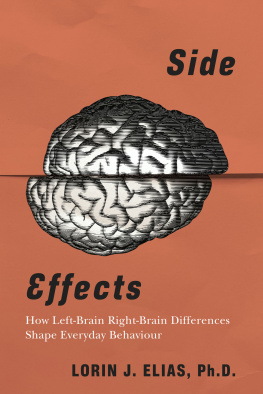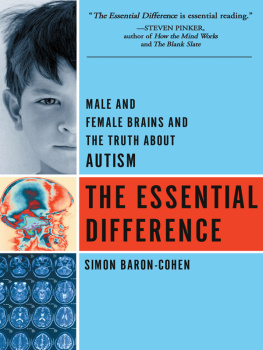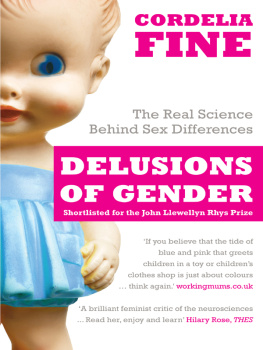H OUGHTON M IFFLIN H ARCOURT Boston New York 2009
Copyright 2009 by Lise Eliot
ALL RIGHTS RESERVED
For information about permission to reproduce selections from this book,
write to Permissions, Houghton Mifflin Harcourt Publishing Company,
215 Park Avenue South, New York, New York 10003.
www.hmhbooks.com
Library of Congress Cataloging-in-Publication Data
Eliot, Lise.
Pink brain, blue brain : how small differences grow into troublesome gaps
and what we can do about it / Lise Eliot,
p. cm.
Includes bibliographical references and index.
ISBN 978-0-618-39311-4
1. Sex differences. 2. Sex differences (Psychology) 3. Developmental
neurobiology. I. Title.
QP 81.5. E 45 2009 612.6dc22 2009014746
All illustrations by Michael Prendergast
Book design by Lisa Diercks
Typeset in Whitman
Printed in the United States of America
DOC 10 9 8 7 6 5 4 3 2 1
Illustration credits appear on .
Contents
Acknowledgments
Introduction
1. Pink and Blue in the Womb
2. Under the Pink or Blue Blankie
3. Learning Through Play in the Preschool Years
4. Starting School
5. The Wonder of Words
6. Sex, Math, and Science
7. Love and War
Notes
Bibliography
Index
Acknowledgments
I F BOOKS ARE LIKE BABIES , this one was an overdue, high-risk delivery. Little did I know when I first conceived a book about sex differences in the brain how complicated and politically sensitive the topic was. Fortunately, I've had many capable midwives to help maneuver through the twists and turns.
Foremost has been Amanda Cook, my wise and probing editor, who's kept me on track and helped wrestle the data into a coherent frame. My fabulous agent, Kim Witherspoon, was always there to hold my hand, along with my dear friend Jenny Cox, who had great insight as both a mother and an editor. I am also grateful to Lisa Glover, Tracy Roe, and Melissa Lotfy at Houghton Mifflin Harcourt, and to Laura Van Dam, who saw the book's promise but who, sadly, I was never able to meet in person.
As for the place of the book's birth, I could not ask for a more supportive environment than Rosalind Franklin University of Medicine and Science. Recently renamed to honor this important female scientist, it is the most strikingly gender-balanced institution I've had the privilege of working at. Thanks to Marina Wolf, Michael Welch, Art Ross, and Michael Sarras for their unparalleled support of scientific scholarship, and to Kevin Robertson for zapping all that scholarship right to my laptop. Many other faculty, staff, and students have buoyed me along the way and I thank them all for making RFUMS such a warm and truly collegial place.
I began this project with a fellowship to the Helen Riaboff Whiteley Center of the University of Washington at Friday Harbor Laboratories and am grateful to Arthur Whiteley and Dennis Willows for creating such a beautiful, inspiring space to work. On the opposite coast, I was able to complete several chapters at the incomparable Marine Biological Laboratory at Woods Hole, Massachusetts, where I thank Colleen Hurter for facilitating all my interlibrary loans and Andrea Walters, Francine Coeytaux, Terry Walters, and David Glanzman for their encouragement and lively dinner discussions.
This book further gestated at the Erikson Institute, another Chicago treasure, where I'm indebted to Linda Gilkerson, Sharon Syc, and many other terrific colleagues who taught me as much about child development as I was able to impart about the brain.
For their continued support of my career, I am grateful to Eric Kandel, Dan Johnston, Margie Ariano, Fred Sierles, Carol Ann Stowe, and Christiana Leonard. I'm also indebted to Susan McGee Bailey for our collaboration on single-sex schooling and to Karen Adolph, Susan Levine, Peter Meijer, Scott Moffatt, Emma Nelson, and Elise Temple for allowing me to reproduce figures from their papers.
Many other scientists have helped by answering questions and sharing insights that don't always appear in their published articles. For their valuable correspondence, I thank Simon Baron-Cohen, Larry Cahill, Sue Carter, Celine Cohen-Bendahan, Lee Cronk, Lisa Donovan, Teresa Farroni, Richard Francis, Jay Giedd, Melvin Grumbach, Janet Hyde, Tatjana Ishunina, Marc Johnson, Sandy Kirkman, Yulia Kovas, Holly Krogh, Mark Lewis, Lynn Liben, Michelle Luciano, Eleanor Maccoby, Dennis McFadden, Helen Neville, Maritza Rivera-Gaxiola, Carolyn Rovee-Collier, Elizabeth Shirtcliff, Courtney Stevens, Andrew Stuart, Shanna Swan, Davida Teller, Claes von Hofsten, and Toni Ziegler. Though we may not agree on everything, I appreciate their open discussions and hope I've done justice to their diligent research.
On the personal side, I could not have completed this work without Veena Bhalala, who befriended and so ably cared for our children after school, and the many wonderful teachers at Dearhaven and the Lake Bluff public schools.
Most of all, I thank my familymy parents, Caryl and Allen, who have always been my bedrock; my brothers, Brian, Dan, and Bruce, and in-laws, Mary Helen and Frosty, who, though far away by land, are always near in my heart; and, especially, my wise and patient husband, Bill, who has never doubted me and has managed, miraculously, to keep the rest of the brood sane along the way. I feel enormously lucky to share this journey with him.
It is this brood of ours that deserves my last and deepest thanks. I can't say that writing this book has made me a better parent, but I do believe it's helped me better appreciate each child's unique mind and personality in ways that go far beyond pink and blue. I love them fiercely and regret all the time and attention this book has taken away from them. Though it's hardly repayment, I dedicate the book to Julia, Sam, and Toby.
Introduction
Y OU'RE FINALLY GETTING to know the new neighbors. They moved in a week ago, but you've had no chance to chat, which is surely why you didn't notice sooner that the woman is pregnant. Very pregnant, by the looks of it.
"How wonderful!" you croon over your common fence. "Do you know if you're having a boy or girl?"
Why is this always the first question we ask when learning about a new baby? The answer is simple: because sex is a big deal. Not just the act of it, but the fact of it. Of all the characteristics a child brings into the world, being male or female still has the greatest impacton future relationships, personality, skills, career, hobbies, health, and even the kind of parent the child is likely to become. That's why 68 percent of expectant parents learn the sex of their child before birth and why you know your neighbor is naive to answer, "We really don't care, as long as the baby is healthy!"
Most American parents hope to have at least one child of each sex. We enjoy the differences between them, even as we worry about their consequences. Will this little boy, now so active and exuberantly affectionate, settle down enough to begin school? Will he form meaningful relationships with his friends and teachers? Will he still express his feelings or, for that matter, communicate with us at all when he grows up?
For parents of girls, the fears run in the opposite direction. Here she is, so confident and full of life. Will she still dig for worms and wonder about the planets when she's in middle school? Will she be assertive enough when she lands her first job out of college? Will it be any easier for her generation to juggle career and family when she grows up?
Boys and girls are different. This fact, obvious to every previous generation, comes as a bewildering revelation to many parents today. Raised in an era of equal rights, we assumeor at least hopethat differences between the sexes are made, not inborn. We mingle comfortably with members of the opposite sex, harangue as easily about sports as cooking, and cheerfully compete in the workplaceall the while pretending the two sexes are more or less the same.
Next page








